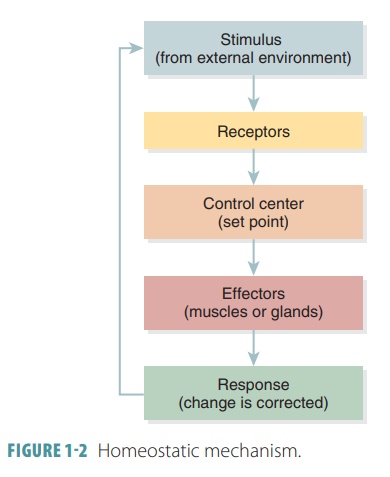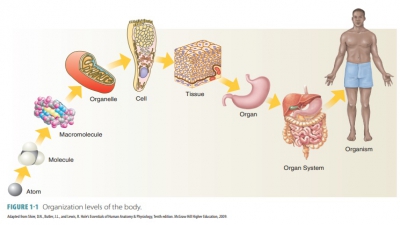Homeostasis
| Home | | Anatomy and Physiology | | Anatomy and Physiology Health Education (APHE) |Chapter: Anatomy and Physiology for Health Professionals: Levels of Organization : Introduction to Human Anatomy and Physiology
1. Define homeostasis. 2. Why is homeostasis essential to survival? 3. Describe two homeostatic mechanisms.
Homeostasis
The internal environment of the
human body must stay relatively stable for the person to survive. Homeostasis is a
term that describes a stable internal body environment. It requires a constant
balance. There must be normal concentrations of nutrients, oxygen, and water.
Heat and pressure must be regulated at tolerable levels. Homeostatic mechanisms regulate the body by neg-ative or positive
feedback.
Homeostatic Control
For homeostasis to occur, the
body primarily uses the nervous and endocrine systems. These systems allow
forms of communication that control homeostasis to occur. The nervous system
uses neural electrical impulses for these activities, whereas the endocrine
system uses blood borne hormones. The nervous system handles rapid, short term,
extremely specific responses. The endocrine system responds more slowly, but
its effects last for a longer duration. The event or factor that is being
controlled (regulated) is referred to as the variable.
The two basic components of
homeostatic control are as follows:
■■ Autoregulation: Also known as intrinsic
regula-tion, this occurs when a body structure or sys-tem adjusts its
activities because of some change in its environment. For example, declining
tissue oxygen levels cause cells to release chemicals that widen local blood
vessels, thereby increasing blood flow rate, which provides more oxygen to the
local area of the body.
■■ Extrinsic regulation: Related
to nervous or endo-crine system activity, these systems influence activ-ities
of many other body systems simultaneously. For example, increased exercise
causes the ner-vous system to increase the heart rate and circulate blood more
quickly. It also reduces blood flow to the digestive tract and other less
active organs. Oxygen in the circulating blood is then available to the active
muscles, which need it the most.
All mechanisms used for
homeostatic control involve at least three components:
■■ Receptors: These are “sensors” that monitor theinternal body
environment and respond to stim-uli. Receptors send information to the control cen-teralong the afferent pathway. You can rememberthis
more easily because the afferent pathway car-ries information that is
“approaching” the control center.
■■ Control center: This is a
point in the body thatdetermines the set
point (the range or level at which a variable must be maintained). It
analyzes the input from the receptors to determine appro-priate responses or
actions. It then sends informa-tion to effectors
via the efferent pathway. You can
remember this more easily because the efferent pathway carries information that
is “exiting” the control center (FIGURE 1-2). The set point for the average body temperature, for example, is
98.6°F (37°C). Another set point is normal adult blood pressure, which is
ideally below 120 (systolic) and under 80 (diastolic).
■■ Effectors: These are
components of homeostaticcontrol that allow the control center to respond to
stimuli. The control center’s response involves negative (reducing) or positive
(enhancing) feed-back. Basically, negative feedback shuts off the control process,
whereas positive feedback makes it occur at a faster rate.

Negative Feedback
A negative feedback mechanism is one that prevents the correction of
deviations from doing too much (which could possibly harm the body). Most of the
feedback mechanisms of the human body use nega-tive feedback. Examples of
negative feedback are blood pressure regulation, erythropoiesis (the production
of red blood cells), body temperature regulation (ther-moregulation), and
control of blood glucose levels. The hypothalamus
of the brain maintains homeostatic con-trol of body temperature.
Information is received from temperature receptors in the skin and within the
hypo-thalamus itself. The normal set
point of body tempera-ture is approximately 98.6°F (37°C). When temperature
rises above this normal, hypothalamic activity targets muscle tissue in walls
of blood vessels that supply the skin, and also targets the sweat glands. This
causes blood flow to increase near the body surface, and accel-eration of sweat
gland secretion. The skin loses heat to the environment, and sweat evaporation
speeds up this process. As temperature lowers back to normal, hypo-thalamic
activity declines, and all processes reverse.
Negative feedback is the main
controller of homeostasis, providing long-term control over inter-nal systems
and body conditions. Minor variations are usually ignored, while normal body
ranges are main-tained instead of exact, fixed values. The regulatory process
works dynamically since set points vary with changes in environment and
activity. While sleeping, thermoregulation has a lower set point than when you
are awake and active. Therefore, temperature varies because of small
fluctuations around the set point, or change in the set point. Similar variations
occur throughout all body physiology.
Set points differ between
individuals based on age, gender, genetic factors, overall health, and the
envi-ronment. There are no actual precise
homeostatic con-ditions. Basically, homeostatic values are either based on
average between large amounts of people, or as a range including 95% (or more)
of those people being sampled. While most healthy adults have body tem-perature
between 98.1°F and 98.9°F (between 36.7°C and 37.2°C), 5% have resting body
temperatures above or below this range.
Positive Feedback
A positive feedback mechanism is one that makes conditions move away
from the normal state to stimulate further changes. They are usually
short-lived and extremely specific actions, producing extreme responses. A positive
feedback mechanism is defined as one that results in or responds in an enhanced
way to the original stimulus, accelerating the result or response. Examples of
positive feedback are the onset of contractions before childbirth, the process
of blood clotting, lactation, the secretion of estrogen during the follicular
phase of menstruation, and the generation of nerve signals.
In positive feedback, cycles escalate and are often referred to as
being part of a positive
feedback loop. These loops are usually found
when a possibly stressful or dangerous body process must be completed quickly
prior to homeostasis being restored. One example is a severe laceration, which
may lower blood pressure and reduce the heart’s effectiveness. As the clotting
process attempts to combat the loss of blood, a positive feed-back loop occurs,
which increases the clotting activities.
Homeostatic Imbalance
Most diseases occur because of homeostatic imbalance (meaning the
disturbance of homeostasis). Aging causes body systems to become less efficient
and more uncontrollable, resulting in instability in the internal body
environment and increasing the risk for illness. Also, when helpful negative
feedback mechanisms become overwhelmed, certain destructive positive feedback
mechanisms can dominate (such as those seen in some forms of heart failure).
Additional examples of homeostatic imbalance include abdom-inal injury due to
physical trauma (and lack of pro-tective bones in this body region), sepsis
(resulting in severe pain, such as in peritonitis), and metabolic acidosis or alkalosis (which can affect all body
systems and lead to death). Trauma may involve hemorrhage and perforation of
abdominal organs. Any cause of homeostatic imbalance can result in death if
untreated.
1. Define
homeostasis.
2. Why is
homeostasis essential to survival?
3. Describe two homeostatic mechanisms.


